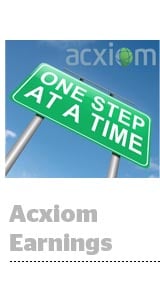 For Acxiom’s 2015 Q3 earnings, it was the best of times, it was the worst of times.
For Acxiom’s 2015 Q3 earnings, it was the best of times, it was the worst of times.
Or, in the words of CEO Scott Howe, “Spectacular growth in AOS and LiveRamp has been mirrored by declines in our core business.” Read the press release.
Howe, speaking during the company’s earnings call Wednesday, was referring to the data connectivity platform Audience Operating System that Acxiom unveiled in 2013 as well as LiveRamp, the onboarding solution it acquired last May. LiveRamp continues to field its own sales force in order to preserve its neutrality, though Howe mentioned during the call Acxiom would roll out a combined connectivity product involving both LiveRamp and AOS.
Regarding the “spectacular growth,” AOS and LiveRamp brought in $21 million in revenue, up 40% from Q2, and Howe said he expects $60 million in combined revenue for FY 2015. Gross media spend in Q3 through AOS was $73 million, up 97% sequentially and 265% YoY.
AOS and LiveRamp customers include – as per the company’s earnings slidedeck – 22 Fortune 100 companies, three global advertising agencies, 17 financial institutions, five automotive manufacturers, 11 media companies, 10 political organizations, 28 retailers and 101 technology providers.
And AOS/LiveRamp prospects remain strong, Howe said, with $90 million in “qualified pipeline.”
So that’s the good news.
The bad news is that Acxiom’s overall revenue was $269 million, a 3% decline YoY. Its IT Infrastructure Management division declined 16% YoY – an expected decrease since Acxiom exited its paper survey business in Europe. More worrying to the company overall, however, was the decrease in its core business, marketing and data services (M&DS).
While M&DS brought in $207 million and grew 1% YoY overall, its US revenue was down 4% YoY, once revenue from AOS and LiveRamp (housed under M&DS) was excluded.
“We lost some contracts – not clients – but work that went away,” Howe said regarding the declines in Acxiom’s legacy business. “Call that $8 million out of the top line. Volume declines – people doing less direct mail or data models – caused another $5 million of top-line leakage. To offset that, we generated $6 million in new business. So net down $7 million.”
Howe confessed that righting Acxiom’s M&DS business has taken longer than he expected and recovery won’t happen overnight.
“We need several consistent quarters of high performance to get us back to a level I’m comfortable with,” he said, adding that he’s aware of moments when Acxiom left potential business on the table.
He noted Acxiom’s data business hasn’t grown whereas competitors in the space had. The reason, Howe said, is that data sales were driven through marketing database clients.
“That’s terrific, but we may be losing out on other opportunities: agencies, publishers, resellers and the like which have grown explosively with their use of data,” Howe said.
He also mentioned Acxiom missed out on sectors that had grown rapidly, like government and health care. “There are likewise opportunities within sectors where we have strong position, where we left money on the table by not developing upsell opportunities,” he said.
He said in recent years Acxiom had drifted from its core value proposition as industry leaders helping clients solve their data-related challenges. Howe added that both clients and internal Acxiom teams felt this way.
“We’ve pushed to re-embrace an industry expertise model,” Howe said.













